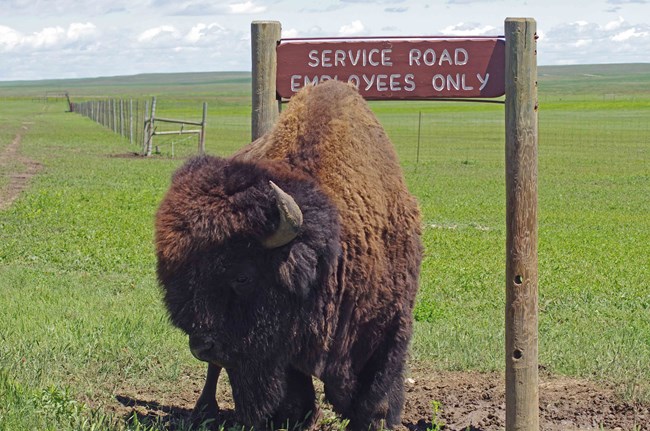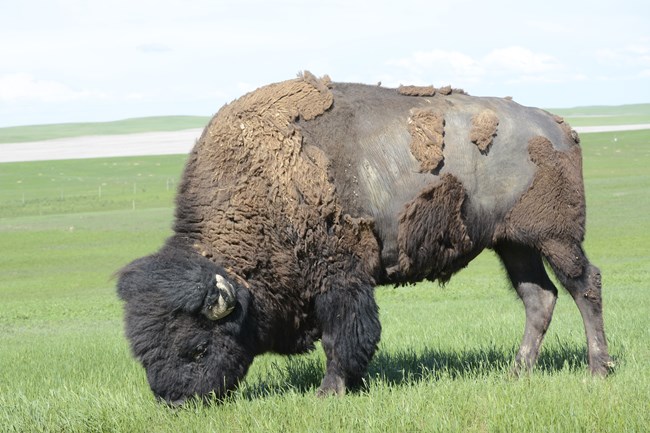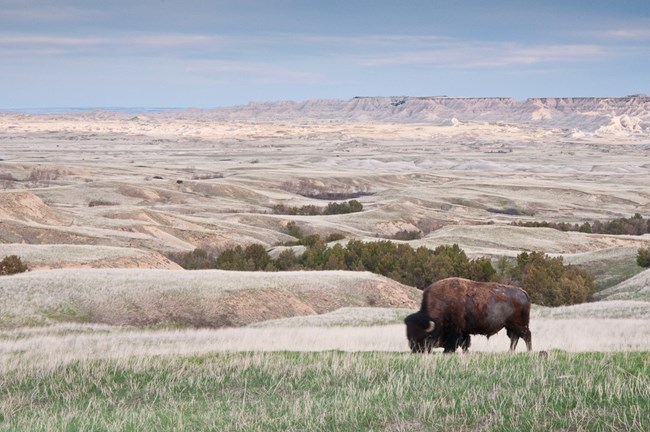what animal was important to the western sioux

NPS Photo / Larry McAfee
Names and lifeways
What's in a name?
There are many names for the American Bison. Scientifically, the plains bison subspecies establish in Badlands National Park are of the genus Bison, of the species bison, and the subspecies bison. If you ask a wild fauna biologist, these animals are called Bison bison bison!
Although these animals have "bison" three times in their scientific proper name, they are often called buffalo. The discussion buffalo is derived from the French "bœuf," a proper name given to bison when French fur trappers working in the United states in the early 1600s saw the animals. The word bœuf came from what the French knew as true buffalo, animals living in Africa and Asia. Although this name was a mix-up of 2 different animals, many people still know bison as buffalo today.
Some other name for these animals is "tatanka." Tatanka is the Lakota discussion for bison. Bison are incredibly of import in Lakota culture; the Lakota are traditionally nomadic and would accept spent their lives following bison before Euro-Americans settled the West. Another word for bison in Lakota is "pte." The Lakota are sometimes known as pte oyate, meaning "buffalo nation."
How many bison have lived in the Usa?
Bison were once abundant in the American landscape. Their natural range extended from Canada to Mexico and from New York to Oregon. Scientists and historians estimate that at that place were at to the lowest degree xxx meg bison roaming the country earlier Euro-American settlement of the West.
Before Euro-American expansion into the West, these millions of bison were a major part of life in Lakota culture. The Lakota people lived as nomads, following herds of bison and hunting them when necessary. Different parts of a bison supplied everything the Lakota needed – food, clothes, blankets, knives, fuel – and every office of the beast was put to apply in one case it had been killed. Bison besides played (and go on to play) an important spiritual role in Lakota life, appearing in many oral histories and spiritual narratives.
When settlers expanded into the American West, these animals nearly disappeared. Major hunting of bison began in 1800 and increased with time as legislation like the Dawes Act and Homesteading Acts passed. While the Lakota utilized every part of the beast, this systematic hunting resulted in a lot of waste – Euro-Americans used only hides, which could be sold as robes or rugs, and tongues, which could be sold every bit a effeminateness. Although this hunting was for often for sport, there was a secondary motive: the United states of america government wanted to disrupt and disband Native American means of life, and i manner to do that was to kill off bison, which were central to the culture and well-being of many plains tribes.
Plummeting from a previous population of 30 million, at that place were an estimated 325 wild bison left in the country by 1884. Luckily, a few conservationists had the foresight to protect the final of this species, and their efforts in the late 19th century are the reason why about 20,000 bison now roam public lands.

NPS Photo / Troy Hunt
Bison Behaviors
A Day in the Life
Bison are enormous animals – they can get up to 6.5 feet tall and weigh up to 2,000 pounds. Their incredible weight makes them the heaviest state mammal in North America! Despite their weight, bison are remarkably active. They tin can run up to 35 mph and have a vertical bound of six anxiety.
Being such a huge fauna ways eating a huge amount of food. Bison are grazers and spend from 9-11 hours every day ingesting up to one.6% of their body mass in forage. Being a ruminant (an animal that chews their cud and has a complex digestive system), bison can go nutrition from difficult, dry fodder where other animals cannot. While grazing, bison roam an average of two miles every day.
A Year in the Life
Many people ask where Badlands bison drift for the winter – and the answer is that they stay right here! Bison are incredibly well-adapted to the cold. They develop a thick winter coat to keep them plenty warm. Their winter coats are so thick that snowfall sits on height of them and never touches the bison's skin. They even utilise their enormous heads, with the help of their supportive neck humps, to plow snow out of their manner while grazing. Sometimes bison most seem impervious to cold – dissimilar almost animals, which turn their backs to the wind, bison face up oncoming winter storms.
In the jump, bison lose their winter coats, ofttimes "wallowing" to loosen winter fur. Wallowing is a behavior in which bison roll around on the ground and cover themselves in mud and dirt. This behavior has many benefits for bison – it helps them to rid of their winter coats, protects them from problems bites, and spreads their scent for mating. Wallowing is also beneficial for prairie ecosystems! It compacts and churns up soil, making way for new plants. The depressions left behind by bison, known as wallows, can as well serve as small water reservoirs. These little ponds benefit other thirsty animals and provide a dwelling house for more water-reliant prairie vegetation.
Bison breed in the summer. Male bison compete for mating rights, butting heads with other bulls. In these competitions, male bison may also lower their heads, hand at the footing, and emit a bellow which can exist heard up to three miles abroad. A bison's gestation period is 9.5 months – similar to a human's! When babies are built-in in the bound, they are called "red dogs" for their resemblance to reddish canine companions.

NPS Photo / Carl Johnson
Bison in the Badlands
While Badlands National Park is well within the historic native range of bison, they had to be reintroduced afterward the species suffered devastating losses in the belatedly 19th century. Bison were returned to the Badlands in 1963, with a source herd transferred from Theodore Roosevelt National Park. The Badlands herd now consists of around 1,200 bison.
The Badlands bison roundup occurs each autumn. During the roundup, rangers collect as many bison from our herd as they tin in our corrals. Once in the corrals, rangers collect biological data from each bison and tag recently born bison. Sick and injured bison besides receive handling at this time. After all the information has been collected, nosotros divide the bison the park will keep from the ones it will not. The bison that the park does not continue volition go to live on other public lands or will be given to groups like the Intertribal Buffalo Quango, which is a coalition of Native American tribes dedicated to preserving traditional buffalo practices.
Nosotros encourage you to keep an eye out for bison on your trip through the Badlands, but please remember that they are wild fauna. Maintain a distance of 100 feet whenever possible and exercise non provoke bison. These animals can cause severe injuries or even deaths if angered.
mattesonreaps1941.blogspot.com
Source: https://www.nps.gov/articles/bison_badl.htm
0 Response to "what animal was important to the western sioux"
Post a Comment